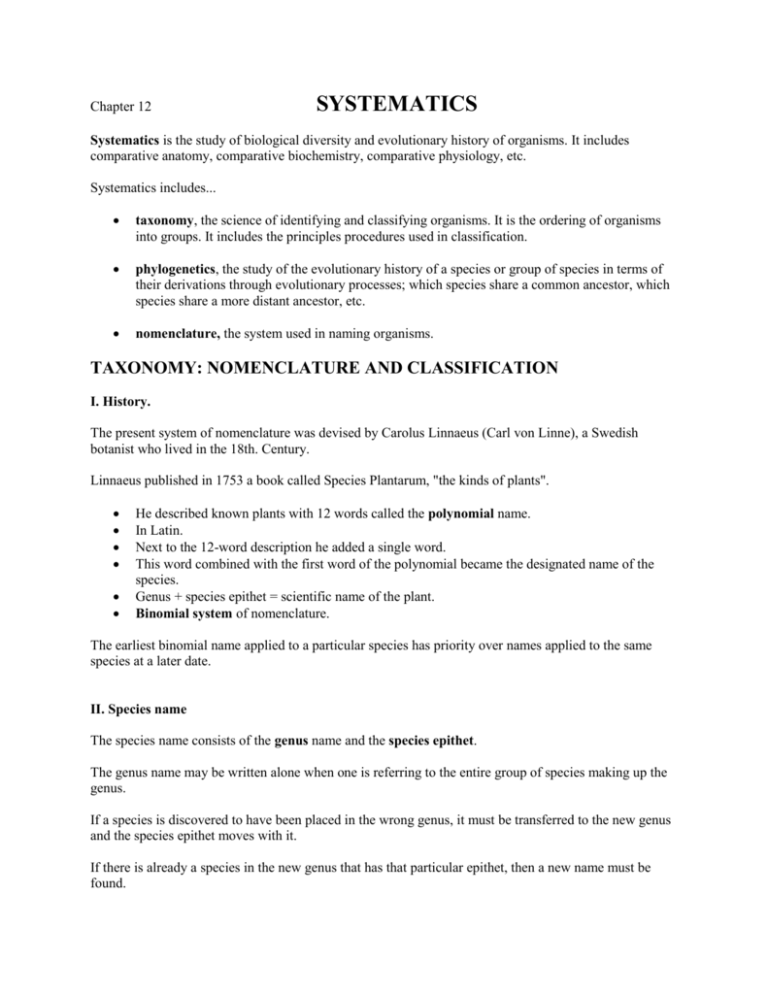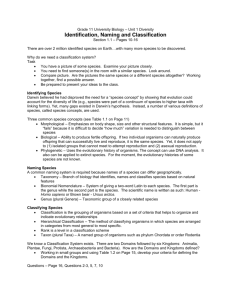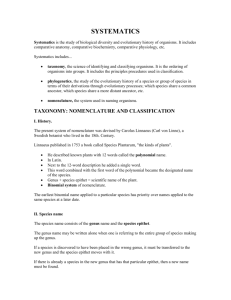ch12 - FacStaff Home Page for CBU
advertisement

Chapter 12 SYSTEMATICS Systematics is the study of biological diversity and evolutionary history of organisms. It includes comparative anatomy, comparative biochemistry, comparative physiology, etc. Systematics includes... taxonomy, the science of identifying and classifying organisms. It is the ordering of organisms into groups. It includes the principles procedures used in classification. phylogenetics, the study of the evolutionary history of a species or group of species in terms of their derivations through evolutionary processes; which species share a common ancestor, which species share a more distant ancestor, etc. nomenclature, the system used in naming organisms. TAXONOMY: NOMENCLATURE AND CLASSIFICATION I. History. The present system of nomenclature was devised by Carolus Linnaeus (Carl von Linne), a Swedish botanist who lived in the 18th. Century. Linnaeus published in 1753 a book called Species Plantarum, "the kinds of plants". He described known plants with 12 words called the polynomial name. In Latin. Next to the 12-word description he added a single word. This word combined with the first word of the polynomial became the designated name of the species. Genus + species epithet = scientific name of the plant. Binomial system of nomenclature. The earliest binomial name applied to a particular species has priority over names applied to the same species at a later date. II. Species name The species name consists of the genus name and the species epithet. The genus name may be written alone when one is referring to the entire group of species making up the genus. If a species is discovered to have been placed in the wrong genus, it must be transferred to the new genus and the species epithet moves with it. If there is already a species in the new genus that has that particular epithet, then a new name must be found. The rules that govern the use of scientific names in botany are codified in the International Code of Botanical Nomenclature. Each species usually has type specimen kept in a museum or herbarium. The type specimen serves as the basis for comparison with other specimens in determining whether they are members of the same species or not. III. Subspecies and varieties. Species may be grouped into subspecies and varieties. All members of a subspecies or variety resemble one another and share one or more features not present in other subspecies and varieties not present in other members of the species. The name of the subspecies consists of the species binomial name and the variety’s name, e. g. Prunus persica var. nectarina; Prunus persica var. persica. IV. Broad taxonomic categories. Linnaeus recognized three kingdoms, which, until recently were the most inclusive unit used in biological classification. Plant, animal and mineral kingdoms. Several taxonomic categories were added between the genus and the kingdom levels Species are grouped into genera (sing. Genus). Genera into families; families into orders; orders into classes; classes into divisions; divisions into kingdoms. Augustin Pyramus de Candolle (1778-1841) added the category Division. A taxonomic grouping is called a taxon. Taxonomy is hierarchical: taxa are grouped into broader taxa; groups within groups. The ending of the name of a particular taxon makes it possible to recognize the taxon at that level. e. g. Aspleniaceae. The ending –aceae is used for families. All family names end in –aceae. IV. Different classification systems Theophrastus (370-285 BC) classified plants according to their appearance: trees, shrubs, undershrubs and herbs. Linnaeus devised a system based on the arrangement and number of stamens in the flower. 24 classes It is called a sexual system because it’s based on male organ of the flower, the stamen. Classification systems like the one of Linnaeus, are based on a few characters and are designed as an aid to identification are referred to as artificial systems. Phylogeny is the evolutionary history of a taxon. It also refers to the description and explanation of the morphological and ecological changes of a taxon over time. Biologists often want that classification reflect the evolutionary relationships of organisms. This evolutionary relationship of species is presented in the form of phylogenetic trees. These systems are referred to as natural systems. Similarity and common ancestry A feature or a trait is called a character. A character may be a morphological characteristic, e.g. presence of hairs, shape of shell, etc. A character may also be a trait at the cellular, biochemical or molecular level, e.g. a particular nucleotide sequence. A character may have several character states, e.g. white or purple flowers, hairs long or short, “A” base or “C” base in particular nucleotide sequence. Ancestral or plesiomorphic characters are found in the common ancestor of daughter species. Derived or apomorphic characters have evolved from the ancestral character. o Synapomorphic characters are derived characters found in two or more species and suggest a close common ancestor. Shared derived characters are evidence of evolutionary relationship. V. Phylogeny In a classification scheme that accurately reflects phylogeny, every taxon is monophyletic. Phylogenetic classification should be monophyletic. Monophyletic means that all the members of a taxon regardless of rank, are descendants of a common ancestor. No descendant should be excluded Monophyly is often difficult to know with certainty. Organisms in a polyphyletic group evolved from different ancestors. Some widely accepted taxa contain members descended from more than one ancestral line. Such taxa are said to be polyphyletic. Other taxa include a common ancestor but not all its descendants. These taxa are said to be paraphyletic. VI. Homologous and analogous features. Homologous features are determined and used to group organisms in natural taxa (monophyletic taxa). Sometimes organisms are grouped into artificial taxa due to lack of knowledge or convenience. Homologous structures show a common plan and are the result of common ancestry or origin. Analogous structures have a superficial resemblance and are the result of convergent evolution; they have a common function but different evolutionary origin. The distinction between homology and analogy is often very difficult and creates disagreements among scientists. CLADISTICS The traditional method is based on the comparison of external features. The cladistic method or phylogenetic analysis focuses on the branching of one group from another in the course of evolution. It attempts to identify monophyletic groups (clades). The groups or clades are identified by the possession of unique features called shared derived character states. Widespread features are called ancestral or preexisting character states. The analysis results in a cladogram. It is the most common method of classification used today. A cladogram is graphical representation of a working model, or hypothesis, of the phylogenetic relationship of a group of organisms. Groups terminating in adjacent branches share a common ancestor. The point where branching occurs is called a node. A fundamental principle of cladistics is that the cladogram should be constructed in the simplest, least complicated, and most efficient way. This is called the Principle of Parsimony. There are scientists who think that the Linnaean system of categories should be abandoned altogether and that taxa could be listed in named groups, but categories like genus, families, orders and other ranks would not be designated. This system is being developed outside the International Code of Botanical Nomenclature and is called the PhyloCode. Check the PhyloCode at http://www.ohiou.edu/phylocode/ MOLECULAR SYSTEMATICS Molecular systematics utilizes amino acid sequencing in proteins and base sequencing in nucleic acids to determine evolutionary relationship. These sequences are genetically determined. Molecular data… Molecular data is easier to quantify Have the potential to provide many more characters for phylogenetic analysis. Allows the comparison of organisms that are morphologically very different. It is possible to compare organisms at their most basic level, the gene. A large body of evidence indicates that protein and nucleic acid sequences are molecular clocks. Their changes in sequences reflect the time that has elapsed since different groups of organisms diverged from one another. A comparison of nucleotide sequences provides evidence for three domains of life. Over 100 prokaryotic genomes have been completely sequenced. The results of this DNA sequencing indicate that the domains Archaea and Eukarya shared a common evolutionary pathway independent of the lineage of Bacteria. The most comprehensive studies of seed plant phylogeny have been based on the variation in nucleotide sequences of the rbcL gene found in the chloroplast. The rbcL gene codes for the large subunit of Rubisco, an enzyme involved in the Calvin Cycle of photosynthesis. This is a slow-evolving, single copy gene that lacks introns and is large enough (about 1500 base pairs) to preserve a significant number of phylogenetically informative characters. THE MAJOR GROUPS OF ORGANISMS: BACTERIA, ARCHAEA AND EUKARYA Some scientists recognize a taxon above the kingdom called domain. Bacteria, Archaea and Eukarya. Bacteria and Eukarya are prokaryotes. The Eukarya includes all the eukaryotes: protists, fungi, plants and animals. Some differences between the domains: (see table 12-3 on page 228.) I. Endosymbiotic Theory. This hypothesis attempts to explain the origin of eukaryotic organelles, mitochondria and chloroplasts. 1. Chloroplasts and mitochondria could have originated from bacteria that were phagocytized by a large heterotrophic prokaryote. An endosymbionts is an organism that lives within another dissimilar organism. 2. These bacteria were then adopted as endosymbionts rather than being digested. 3. With time these endosymbionts became simplified and specialized to perform only photosynthesis or respiration. 4. The DNA of the endosymbionts and many or its functions were transferred to the nuclear DNA. The nuclear membrane could have originated from an infolding of the plasma membrane of a prokaryote. Prokaryotes have their single circular chromosome attached to the plasma membrane. Infolding of other portions of the plasma membrane may have given origin to the ER and Golgi complex. II. Eukaryotic kingdoms. The divisions within the eukaryotic kingdoms are not clear-cut. Plants, animals and fungi are probably monophyletic groups, and the kingdom Protista is paraphyletic. 1. Kingdom Fungi Fungi are... Mostly multicellular; some unicellular. Nonmotile filamentous eukaryotes. Heterotrophs that absorb nutrients after extracellular digestion. Lack plastids. Matrix of the cell wall includes chitin. Structures where spores are formed are often complex. Reproductive cycle usually involve sexual and asexual stages and can be complex. Comparison of ribosomal RNA indicates that fungi are more closely related to animals than to plants. Animals and fungi apparently share a common evolutionary history in which the most recent common ancestor is a flagellated protist similar to modern choanoflagellates. 2. Kingdom Animalia Animals are... Multicellular. Eukaryotes. Lack cell wall, plastids and photosynthetic pigments. Nutrition is primarily ingestive with digestion in an internal cavity; absorptive in some and other lack an internal cavity. Tissue differentiation is complex, particularly the development of the sensory and neuromotor systems. Reproduction is primarily sexual. 3. Kingdom Protista (Protoctista) The kingdom Protista is a paraphyletic group that includes a very heterogeneous assemblage of unicellular, colonial, and multicellular eukaryotes that do not have distinctive characteristics of fungi, animals or plants (bryophytes and vascular plants). Protists are.... Unicellular, colonial or multicellular. Eukaryotes. Heterotrophs or autotrophs. Live in watery environments. Reproductive cycles vary but usually involve cell division and sexual reproduction. May be motile by a 9+2 flagellum or by amoeboid movement, or non-motile. Evolved 1.5 billion years ago Are classified into three main categories. A polyphyletic group. On group of protists, the algae, are ancestral to land plants. Some evolutionary biologists place the algae, bryophytes and vascular plants in the clade Viridophyta. 4. Kingdom Plantae. Plants are... Multicellular. Eukaryotes. Autotrophs; a few species have become heterotrophs. Cell wall that contains cellulose, plastids and photosynthetic pigments. Alternation of generations. In the most advanced member, the haploid generation, the gametophyte, has become much reduced. Presence of an embryo in the sporophytic phase of the life cycle. 5. There are three principal types of life cycles involving sexual reproduction Zygotic meiosis The zygote divides by meiosis to form four haploid cells that divide by mitosis to produce more haploid cells or a single multicellular haploid individual. Gametic meiosis Haploid gametes are formed by meiosis in a diploid organism and fuse to form a diploid zygote that produces another diploid individual. Sporic meiosis or alternation of generation The sporophyte or diploid individual produces spores by meiosis; the spores do not function as gametes but undergo mitosis and give rise to multicellular haploid individuals called gametophytes; the haploid gametophytes produce haploid gametes that fuse to form diploid sporophytes. When the haploid and diploid generations are similar in appearance they are said to be isomorphic. When the two generations are dissimilar, they are called heteromorphic generations.







![[Type text] Taxonomy and Classification Notes Taxonomy: the study](http://s3.studylib.net/store/data/006833839_1-e22256a74f9158844d75d24ddb12e551-300x300.png)